Macroeconomics Assignment: GDP, Unemployment, AD/AS Analysis Report
VerifiedAdded on 2021/06/16
|14
|2649
|32
Homework Assignment
AI Summary
This macroeconomics assignment delves into key economic indicators and concepts. It begins with calculations of GDP, GNP, NNP, and NDP using both expenditure and income approaches, followed by an analysis of net exports and the current account balance. The assignment further explores the relationship between national saving and the current account, along with an explanation of the balance of payments. It then describes macroeconomic indicators, including leading and coincident indicators, and examines the GDP gap and its impact on unemployment. The impact of investing national output for stimulating growth is also discussed. The assignment also examines the relationship between full employment, frictional, structural, seasonal, and cyclical unemployment, as well as the relationship between unemployment and underemployment rates. Finally, it analyzes the aggregate demand and supply curves, including the slope of the aggregate demand curve and shifts in both the aggregate demand and supply curves due to various economic factors such as changes in consumer expectations, government spending, exchange rates, oil prices, wage demands, electricity prices, and business regulations. The document concludes with a list of cited references.
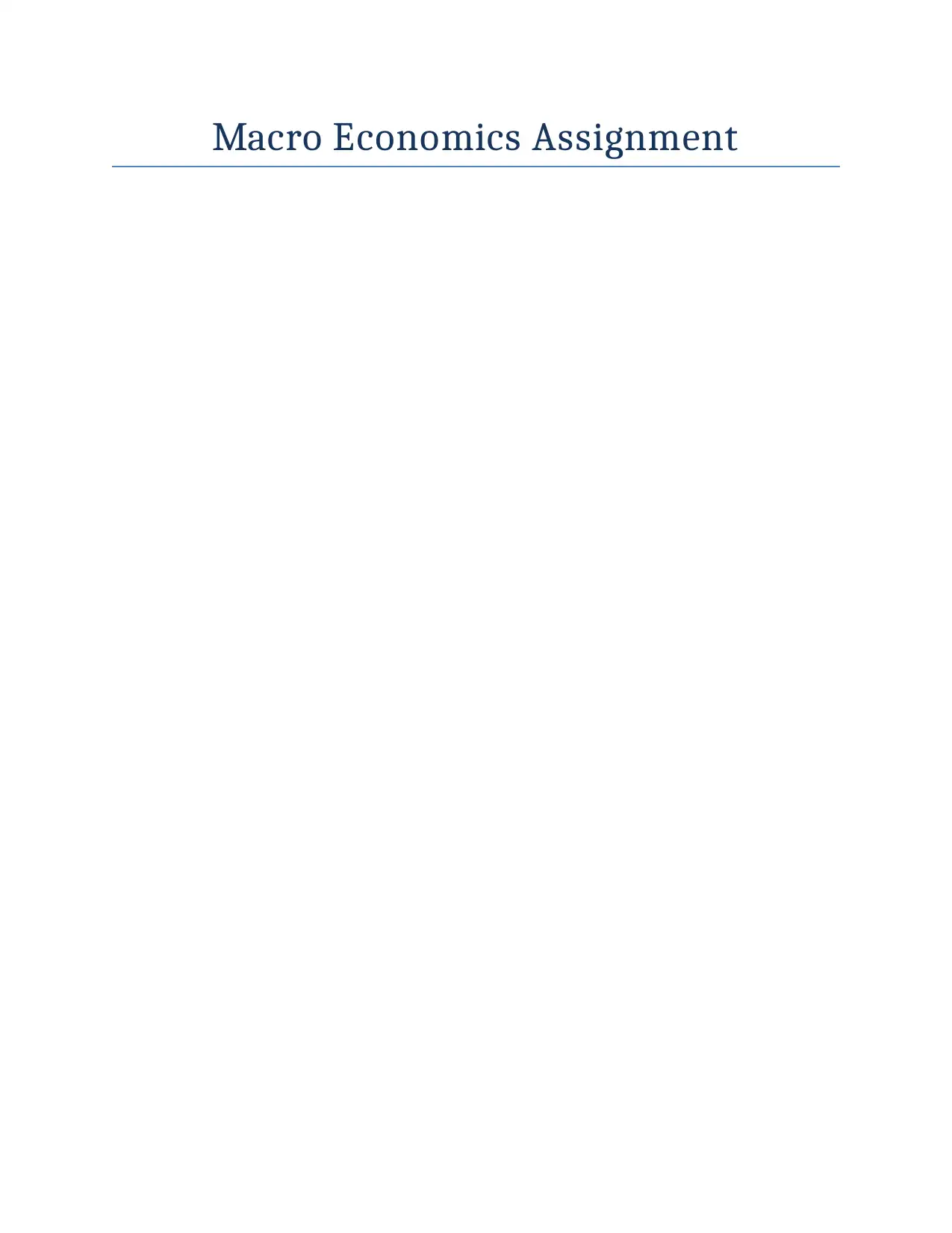
Macro Economics Assignment
Paraphrase This Document
Need a fresh take? Get an instant paraphrase of this document with our AI Paraphraser
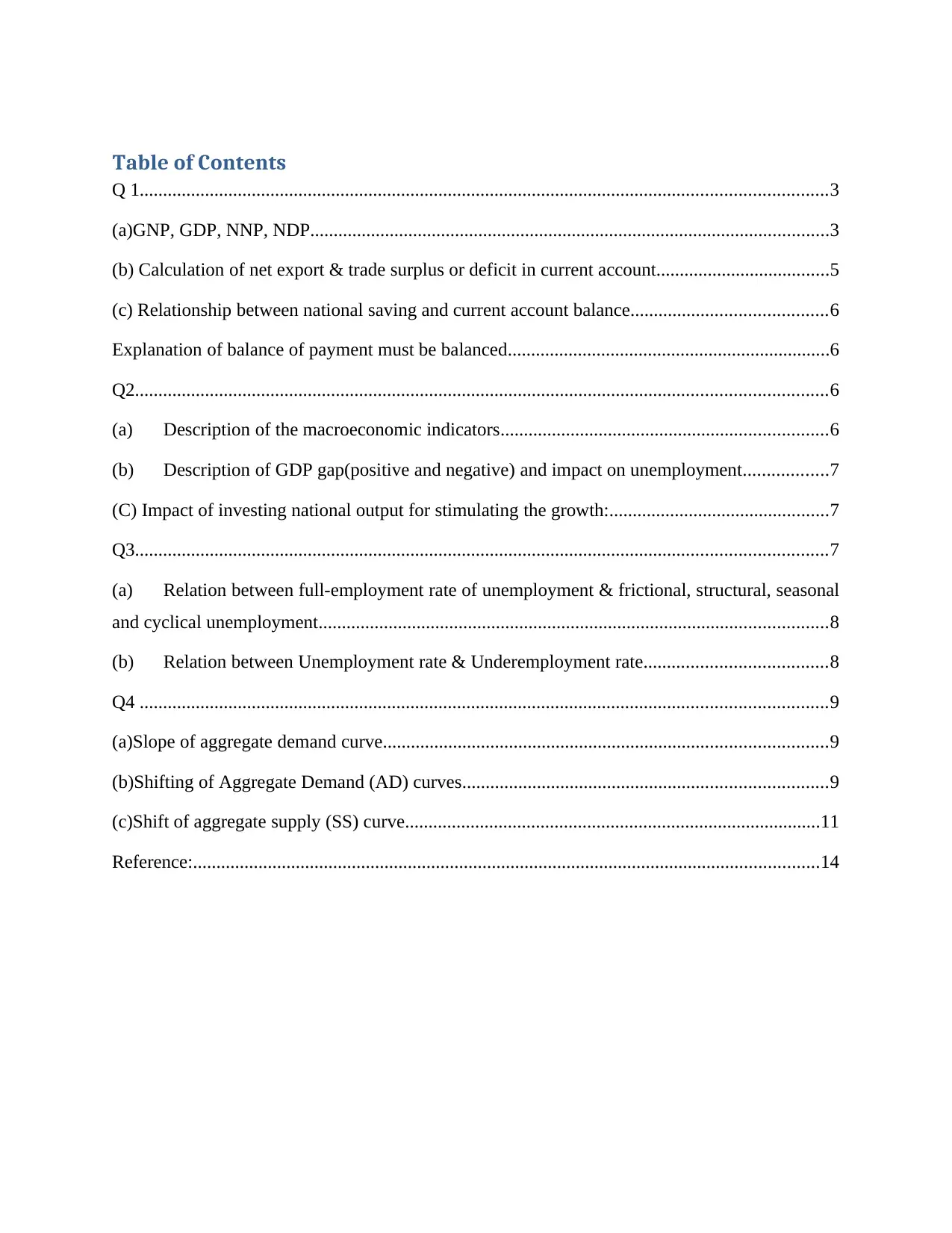
Table of Contents
Q 1...................................................................................................................................................3
(a)GNP, GDP, NNP, NDP...............................................................................................................3
(b) Calculation of net export & trade surplus or deficit in current account.....................................5
(c) Relationship between national saving and current account balance..........................................6
Explanation of balance of payment must be balanced.....................................................................6
Q2....................................................................................................................................................6
(a) Description of the macroeconomic indicators......................................................................6
(b) Description of GDP gap(positive and negative) and impact on unemployment..................7
(C) Impact of investing national output for stimulating the growth:...............................................7
Q3....................................................................................................................................................7
(a) Relation between full-employment rate of unemployment & frictional, structural, seasonal
and cyclical unemployment.............................................................................................................8
(b) Relation between Unemployment rate & Underemployment rate.......................................8
Q4 ...................................................................................................................................................9
(a)Slope of aggregate demand curve...............................................................................................9
(b)Shifting of Aggregate Demand (AD) curves..............................................................................9
(c)Shift of aggregate supply (SS) curve.........................................................................................11
Reference:......................................................................................................................................14
Q 1...................................................................................................................................................3
(a)GNP, GDP, NNP, NDP...............................................................................................................3
(b) Calculation of net export & trade surplus or deficit in current account.....................................5
(c) Relationship between national saving and current account balance..........................................6
Explanation of balance of payment must be balanced.....................................................................6
Q2....................................................................................................................................................6
(a) Description of the macroeconomic indicators......................................................................6
(b) Description of GDP gap(positive and negative) and impact on unemployment..................7
(C) Impact of investing national output for stimulating the growth:...............................................7
Q3....................................................................................................................................................7
(a) Relation between full-employment rate of unemployment & frictional, structural, seasonal
and cyclical unemployment.............................................................................................................8
(b) Relation between Unemployment rate & Underemployment rate.......................................8
Q4 ...................................................................................................................................................9
(a)Slope of aggregate demand curve...............................................................................................9
(b)Shifting of Aggregate Demand (AD) curves..............................................................................9
(c)Shift of aggregate supply (SS) curve.........................................................................................11
Reference:......................................................................................................................................14
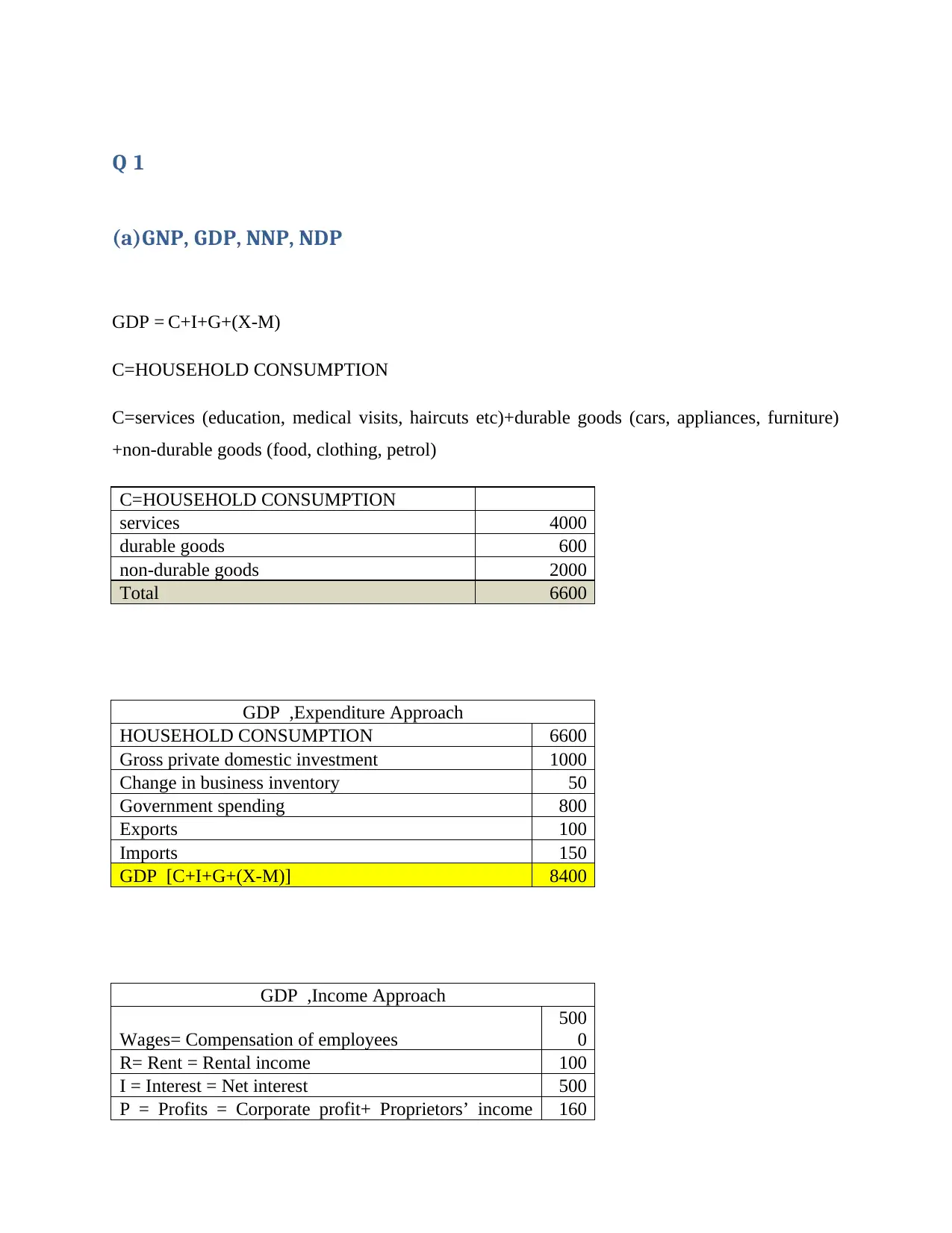
Q 1
(a)GNP, GDP, NNP, NDP
GDP = C+I+G+(X-M)
C=HOUSEHOLD CONSUMPTION
C=services (education, medical visits, haircuts etc)+durable goods (cars, appliances, furniture)
+non-durable goods (food, clothing, petrol)
C=HOUSEHOLD CONSUMPTION
services 4000
durable goods 600
non-durable goods 2000
Total 6600
GDP ,Expenditure Approach
HOUSEHOLD CONSUMPTION 6600
Gross private domestic investment 1000
Change in business inventory 50
Government spending 800
Exports 100
Imports 150
GDP [C+I+G+(X-M)] 8400
GDP ,Income Approach
Wages= Compensation of employees
500
0
R= Rent = Rental income 100
I = Interest = Net interest 500
P = Profits = Corporate profit+ Proprietors’ income 160
(a)GNP, GDP, NNP, NDP
GDP = C+I+G+(X-M)
C=HOUSEHOLD CONSUMPTION
C=services (education, medical visits, haircuts etc)+durable goods (cars, appliances, furniture)
+non-durable goods (food, clothing, petrol)
C=HOUSEHOLD CONSUMPTION
services 4000
durable goods 600
non-durable goods 2000
Total 6600
GDP ,Expenditure Approach
HOUSEHOLD CONSUMPTION 6600
Gross private domestic investment 1000
Change in business inventory 50
Government spending 800
Exports 100
Imports 150
GDP [C+I+G+(X-M)] 8400
GDP ,Income Approach
Wages= Compensation of employees
500
0
R= Rent = Rental income 100
I = Interest = Net interest 500
P = Profits = Corporate profit+ Proprietors’ income 160
⊘ This is a preview!⊘
Do you want full access?
Subscribe today to unlock all pages.

Trusted by 1+ million students worldwide
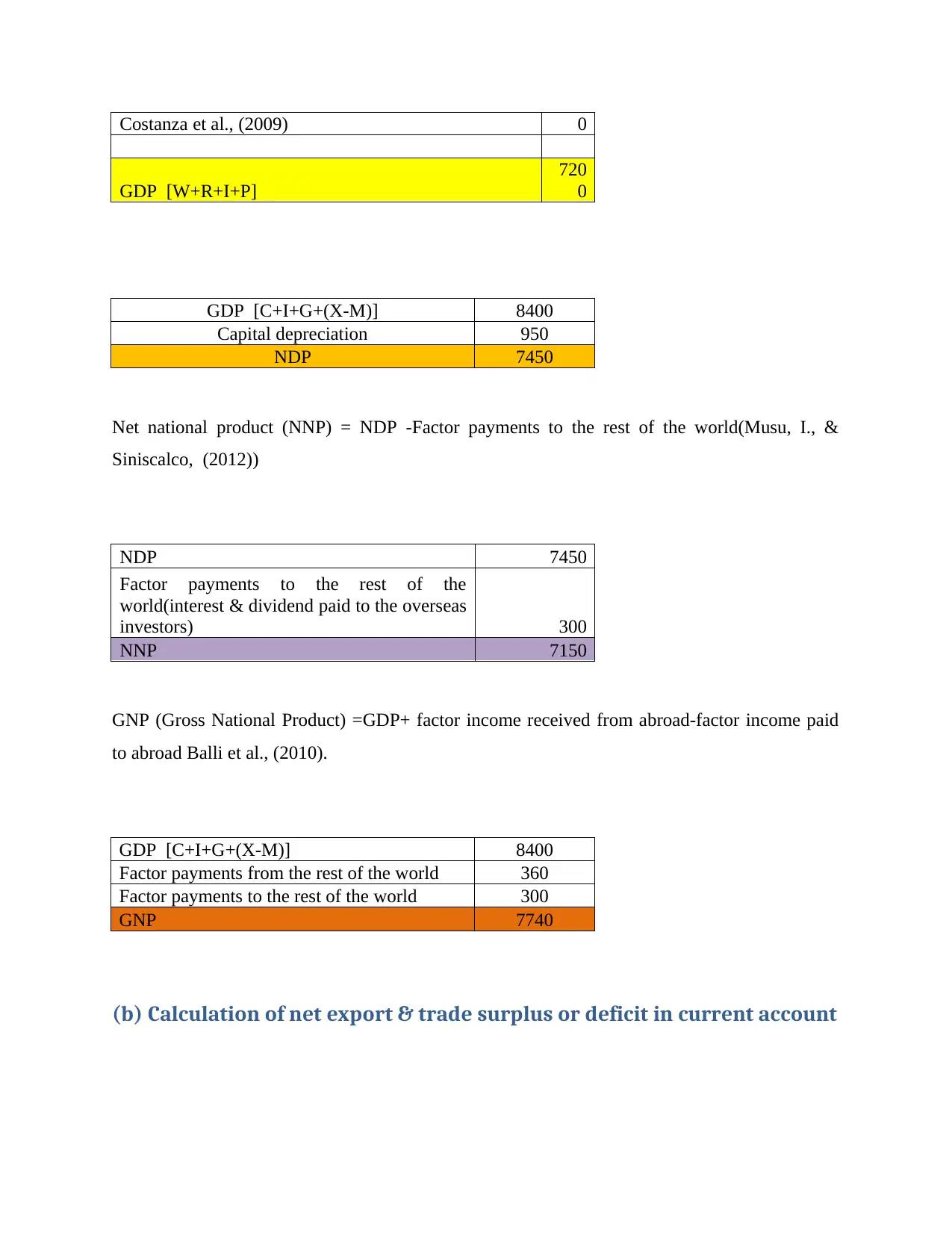
Costanza et al., (2009) 0
GDP [W+R+I+P]
720
0
GDP [C+I+G+(X-M)] 8400
Capital depreciation 950
NDP 7450
Net national product (NNP) = NDP -Factor payments to the rest of the world(Musu, I., &
Siniscalco, (2012))
NDP 7450
Factor payments to the rest of the
world(interest & dividend paid to the overseas
investors) 300
NNP 7150
GNP (Gross National Product) =GDP+ factor income received from abroad-factor income paid
to abroad Balli et al., (2010).
GDP [C+I+G+(X-M)] 8400
Factor payments from the rest of the world 360
Factor payments to the rest of the world 300
GNP 7740
(b) Calculation of net export & trade surplus or deficit in current account
GDP [W+R+I+P]
720
0
GDP [C+I+G+(X-M)] 8400
Capital depreciation 950
NDP 7450
Net national product (NNP) = NDP -Factor payments to the rest of the world(Musu, I., &
Siniscalco, (2012))
NDP 7450
Factor payments to the rest of the
world(interest & dividend paid to the overseas
investors) 300
NNP 7150
GNP (Gross National Product) =GDP+ factor income received from abroad-factor income paid
to abroad Balli et al., (2010).
GDP [C+I+G+(X-M)] 8400
Factor payments from the rest of the world 360
Factor payments to the rest of the world 300
GNP 7740
(b) Calculation of net export & trade surplus or deficit in current account
Paraphrase This Document
Need a fresh take? Get an instant paraphrase of this document with our AI Paraphraser
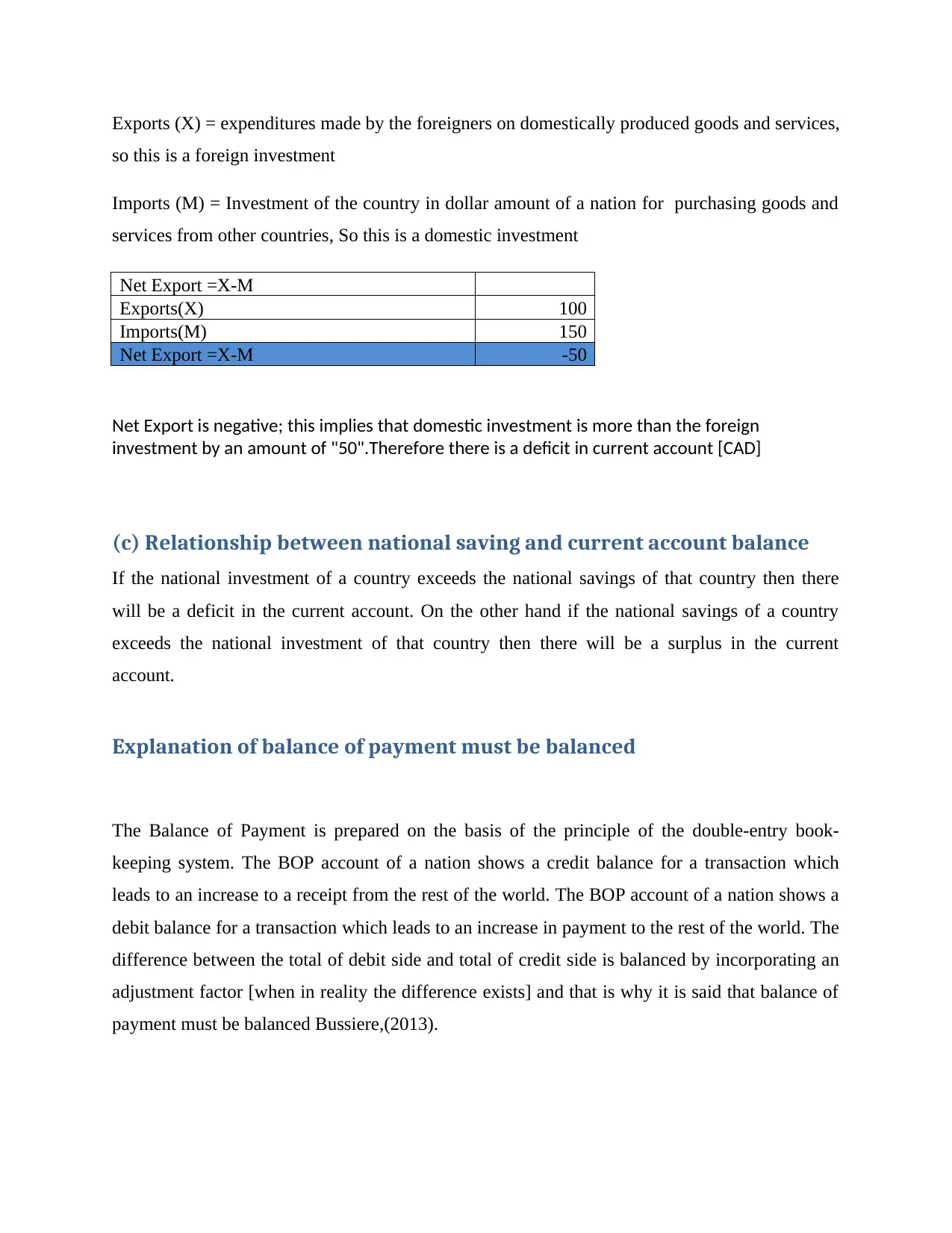
Exports (X) = expenditures made by the foreigners on domestically produced goods and services,
so this is a foreign investment
Imports (M) = Investment of the country in dollar amount of a nation for purchasing goods and
services from other countries, So this is a domestic investment
Net Export =X-M
Exports(X) 100
Imports(M) 150
Net Export =X-M -50
Net Export is negative; this implies that domestic investment is more than the foreign
investment by an amount of "50".Therefore there is a deficit in current account [CAD]
(c) Relationship between national saving and current account balance
If the national investment of a country exceeds the national savings of that country then there
will be a deficit in the current account. On the other hand if the national savings of a country
exceeds the national investment of that country then there will be a surplus in the current
account.
Explanation of balance of payment must be balanced
The Balance of Payment is prepared on the basis of the principle of the double-entry book-
keeping system. The BOP account of a nation shows a credit balance for a transaction which
leads to an increase to a receipt from the rest of the world. The BOP account of a nation shows a
debit balance for a transaction which leads to an increase in payment to the rest of the world. The
difference between the total of debit side and total of credit side is balanced by incorporating an
adjustment factor [when in reality the difference exists] and that is why it is said that balance of
payment must be balanced Bussiere,(2013).
so this is a foreign investment
Imports (M) = Investment of the country in dollar amount of a nation for purchasing goods and
services from other countries, So this is a domestic investment
Net Export =X-M
Exports(X) 100
Imports(M) 150
Net Export =X-M -50
Net Export is negative; this implies that domestic investment is more than the foreign
investment by an amount of "50".Therefore there is a deficit in current account [CAD]
(c) Relationship between national saving and current account balance
If the national investment of a country exceeds the national savings of that country then there
will be a deficit in the current account. On the other hand if the national savings of a country
exceeds the national investment of that country then there will be a surplus in the current
account.
Explanation of balance of payment must be balanced
The Balance of Payment is prepared on the basis of the principle of the double-entry book-
keeping system. The BOP account of a nation shows a credit balance for a transaction which
leads to an increase to a receipt from the rest of the world. The BOP account of a nation shows a
debit balance for a transaction which leads to an increase in payment to the rest of the world. The
difference between the total of debit side and total of credit side is balanced by incorporating an
adjustment factor [when in reality the difference exists] and that is why it is said that balance of
payment must be balanced Bussiere,(2013).
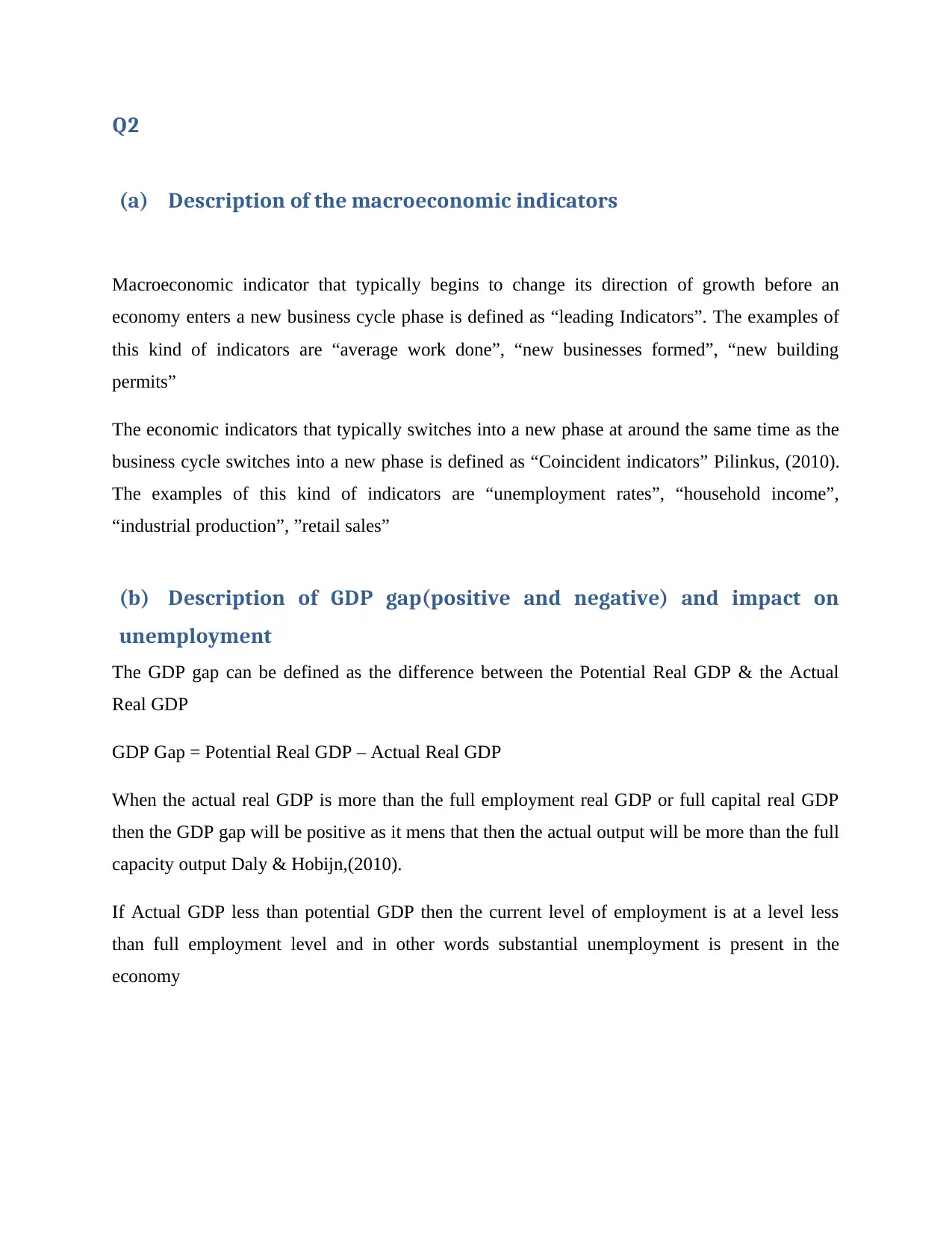
Q2
(a) Description of the macroeconomic indicators
Macroeconomic indicator that typically begins to change its direction of growth before an
economy enters a new business cycle phase is defined as “leading Indicators”. The examples of
this kind of indicators are “average work done”, “new businesses formed”, “new building
permits”
The economic indicators that typically switches into a new phase at around the same time as the
business cycle switches into a new phase is defined as “Coincident indicators” Pilinkus, (2010).
The examples of this kind of indicators are “unemployment rates”, “household income”,
“industrial production”, ”retail sales”
(b) Description of GDP gap(positive and negative) and impact on
unemployment
The GDP gap can be defined as the difference between the Potential Real GDP & the Actual
Real GDP
GDP Gap = Potential Real GDP – Actual Real GDP
When the actual real GDP is more than the full employment real GDP or full capital real GDP
then the GDP gap will be positive as it mens that then the actual output will be more than the full
capacity output Daly & Hobijn,(2010).
If Actual GDP less than potential GDP then the current level of employment is at a level less
than full employment level and in other words substantial unemployment is present in the
economy
(a) Description of the macroeconomic indicators
Macroeconomic indicator that typically begins to change its direction of growth before an
economy enters a new business cycle phase is defined as “leading Indicators”. The examples of
this kind of indicators are “average work done”, “new businesses formed”, “new building
permits”
The economic indicators that typically switches into a new phase at around the same time as the
business cycle switches into a new phase is defined as “Coincident indicators” Pilinkus, (2010).
The examples of this kind of indicators are “unemployment rates”, “household income”,
“industrial production”, ”retail sales”
(b) Description of GDP gap(positive and negative) and impact on
unemployment
The GDP gap can be defined as the difference between the Potential Real GDP & the Actual
Real GDP
GDP Gap = Potential Real GDP – Actual Real GDP
When the actual real GDP is more than the full employment real GDP or full capital real GDP
then the GDP gap will be positive as it mens that then the actual output will be more than the full
capacity output Daly & Hobijn,(2010).
If Actual GDP less than potential GDP then the current level of employment is at a level less
than full employment level and in other words substantial unemployment is present in the
economy
⊘ This is a preview!⊘
Do you want full access?
Subscribe today to unlock all pages.

Trusted by 1+ million students worldwide
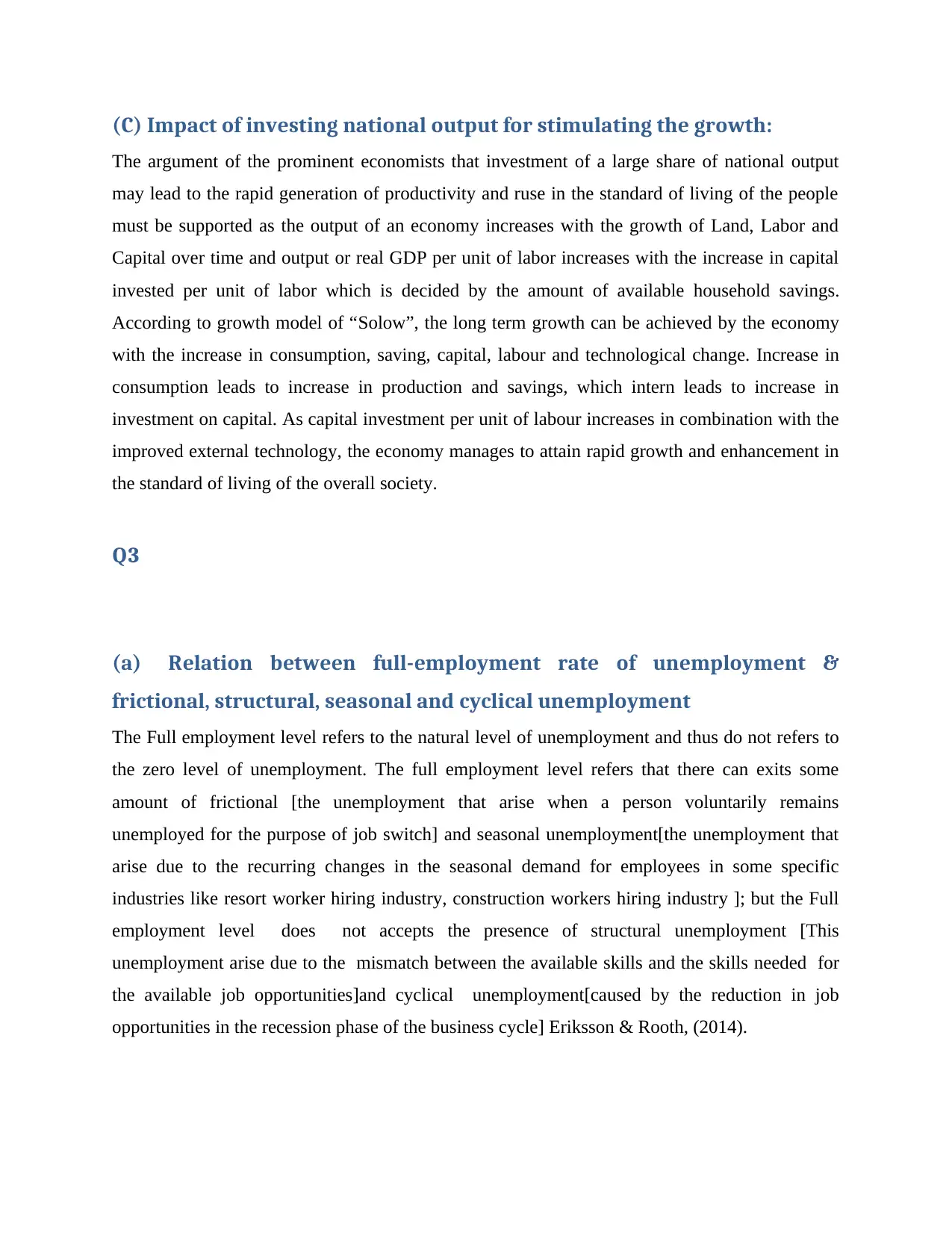
(C) Impact of investing national output for stimulating the growth:
The argument of the prominent economists that investment of a large share of national output
may lead to the rapid generation of productivity and ruse in the standard of living of the people
must be supported as the output of an economy increases with the growth of Land, Labor and
Capital over time and output or real GDP per unit of labor increases with the increase in capital
invested per unit of labor which is decided by the amount of available household savings.
According to growth model of “Solow”, the long term growth can be achieved by the economy
with the increase in consumption, saving, capital, labour and technological change. Increase in
consumption leads to increase in production and savings, which intern leads to increase in
investment on capital. As capital investment per unit of labour increases in combination with the
improved external technology, the economy manages to attain rapid growth and enhancement in
the standard of living of the overall society.
Q3
(a) Relation between full-employment rate of unemployment &
frictional, structural, seasonal and cyclical unemployment
The Full employment level refers to the natural level of unemployment and thus do not refers to
the zero level of unemployment. The full employment level refers that there can exits some
amount of frictional [the unemployment that arise when a person voluntarily remains
unemployed for the purpose of job switch] and seasonal unemployment[the unemployment that
arise due to the recurring changes in the seasonal demand for employees in some specific
industries like resort worker hiring industry, construction workers hiring industry ]; but the Full
employment level does not accepts the presence of structural unemployment [This
unemployment arise due to the mismatch between the available skills and the skills needed for
the available job opportunities]and cyclical unemployment[caused by the reduction in job
opportunities in the recession phase of the business cycle] Eriksson & Rooth, (2014).
The argument of the prominent economists that investment of a large share of national output
may lead to the rapid generation of productivity and ruse in the standard of living of the people
must be supported as the output of an economy increases with the growth of Land, Labor and
Capital over time and output or real GDP per unit of labor increases with the increase in capital
invested per unit of labor which is decided by the amount of available household savings.
According to growth model of “Solow”, the long term growth can be achieved by the economy
with the increase in consumption, saving, capital, labour and technological change. Increase in
consumption leads to increase in production and savings, which intern leads to increase in
investment on capital. As capital investment per unit of labour increases in combination with the
improved external technology, the economy manages to attain rapid growth and enhancement in
the standard of living of the overall society.
Q3
(a) Relation between full-employment rate of unemployment &
frictional, structural, seasonal and cyclical unemployment
The Full employment level refers to the natural level of unemployment and thus do not refers to
the zero level of unemployment. The full employment level refers that there can exits some
amount of frictional [the unemployment that arise when a person voluntarily remains
unemployed for the purpose of job switch] and seasonal unemployment[the unemployment that
arise due to the recurring changes in the seasonal demand for employees in some specific
industries like resort worker hiring industry, construction workers hiring industry ]; but the Full
employment level does not accepts the presence of structural unemployment [This
unemployment arise due to the mismatch between the available skills and the skills needed for
the available job opportunities]and cyclical unemployment[caused by the reduction in job
opportunities in the recession phase of the business cycle] Eriksson & Rooth, (2014).
Paraphrase This Document
Need a fresh take? Get an instant paraphrase of this document with our AI Paraphraser
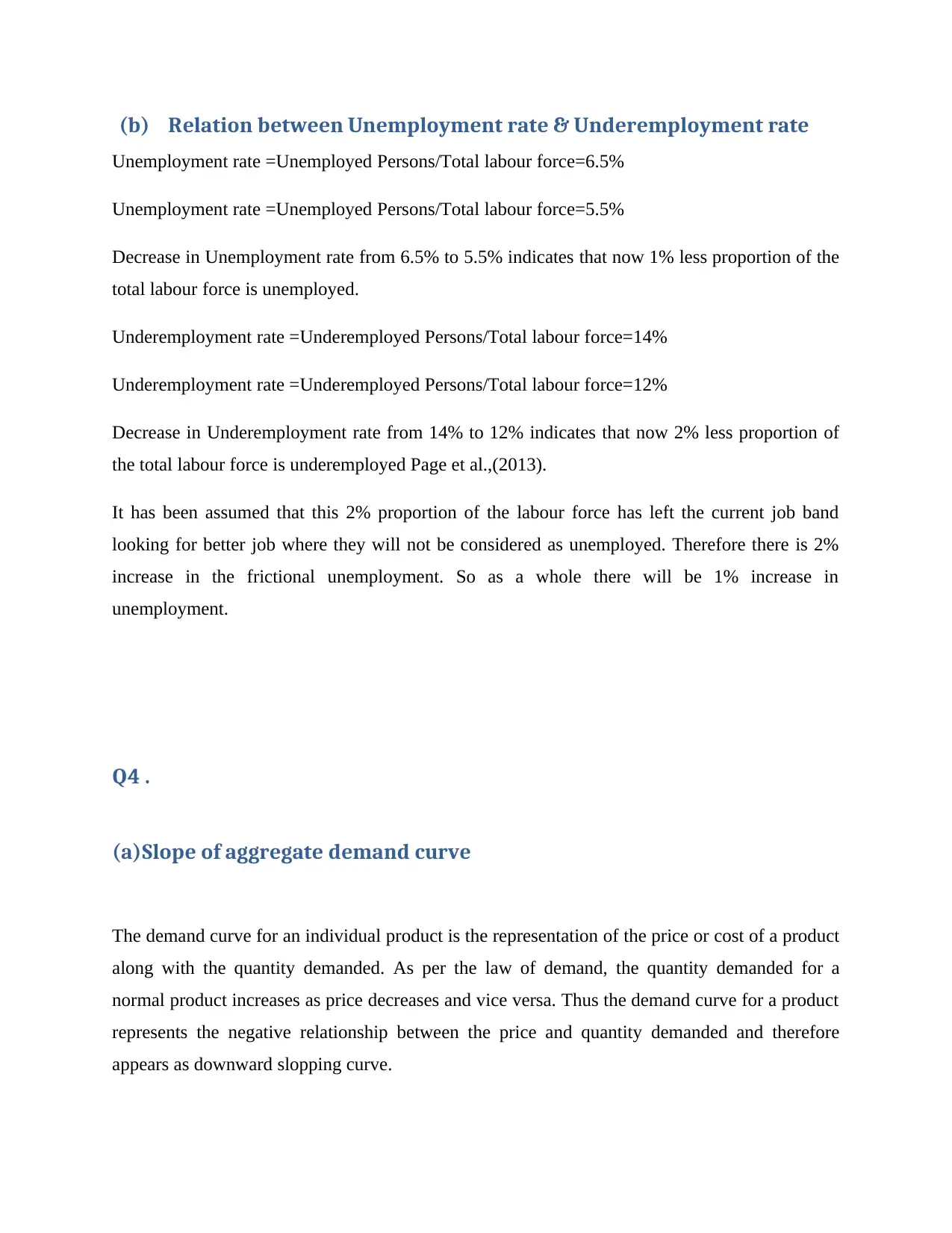
(b) Relation between Unemployment rate & Underemployment rate
Unemployment rate =Unemployed Persons/Total labour force=6.5%
Unemployment rate =Unemployed Persons/Total labour force=5.5%
Decrease in Unemployment rate from 6.5% to 5.5% indicates that now 1% less proportion of the
total labour force is unemployed.
Underemployment rate =Underemployed Persons/Total labour force=14%
Underemployment rate =Underemployed Persons/Total labour force=12%
Decrease in Underemployment rate from 14% to 12% indicates that now 2% less proportion of
the total labour force is underemployed Page et al.,(2013).
It has been assumed that this 2% proportion of the labour force has left the current job band
looking for better job where they will not be considered as unemployed. Therefore there is 2%
increase in the frictional unemployment. So as a whole there will be 1% increase in
unemployment.
Q4 .
(a)Slope of aggregate demand curve
The demand curve for an individual product is the representation of the price or cost of a product
along with the quantity demanded. As per the law of demand, the quantity demanded for a
normal product increases as price decreases and vice versa. Thus the demand curve for a product
represents the negative relationship between the price and quantity demanded and therefore
appears as downward slopping curve.
Unemployment rate =Unemployed Persons/Total labour force=6.5%
Unemployment rate =Unemployed Persons/Total labour force=5.5%
Decrease in Unemployment rate from 6.5% to 5.5% indicates that now 1% less proportion of the
total labour force is unemployed.
Underemployment rate =Underemployed Persons/Total labour force=14%
Underemployment rate =Underemployed Persons/Total labour force=12%
Decrease in Underemployment rate from 14% to 12% indicates that now 2% less proportion of
the total labour force is underemployed Page et al.,(2013).
It has been assumed that this 2% proportion of the labour force has left the current job band
looking for better job where they will not be considered as unemployed. Therefore there is 2%
increase in the frictional unemployment. So as a whole there will be 1% increase in
unemployment.
Q4 .
(a)Slope of aggregate demand curve
The demand curve for an individual product is the representation of the price or cost of a product
along with the quantity demanded. As per the law of demand, the quantity demanded for a
normal product increases as price decreases and vice versa. Thus the demand curve for a product
represents the negative relationship between the price and quantity demanded and therefore
appears as downward slopping curve.
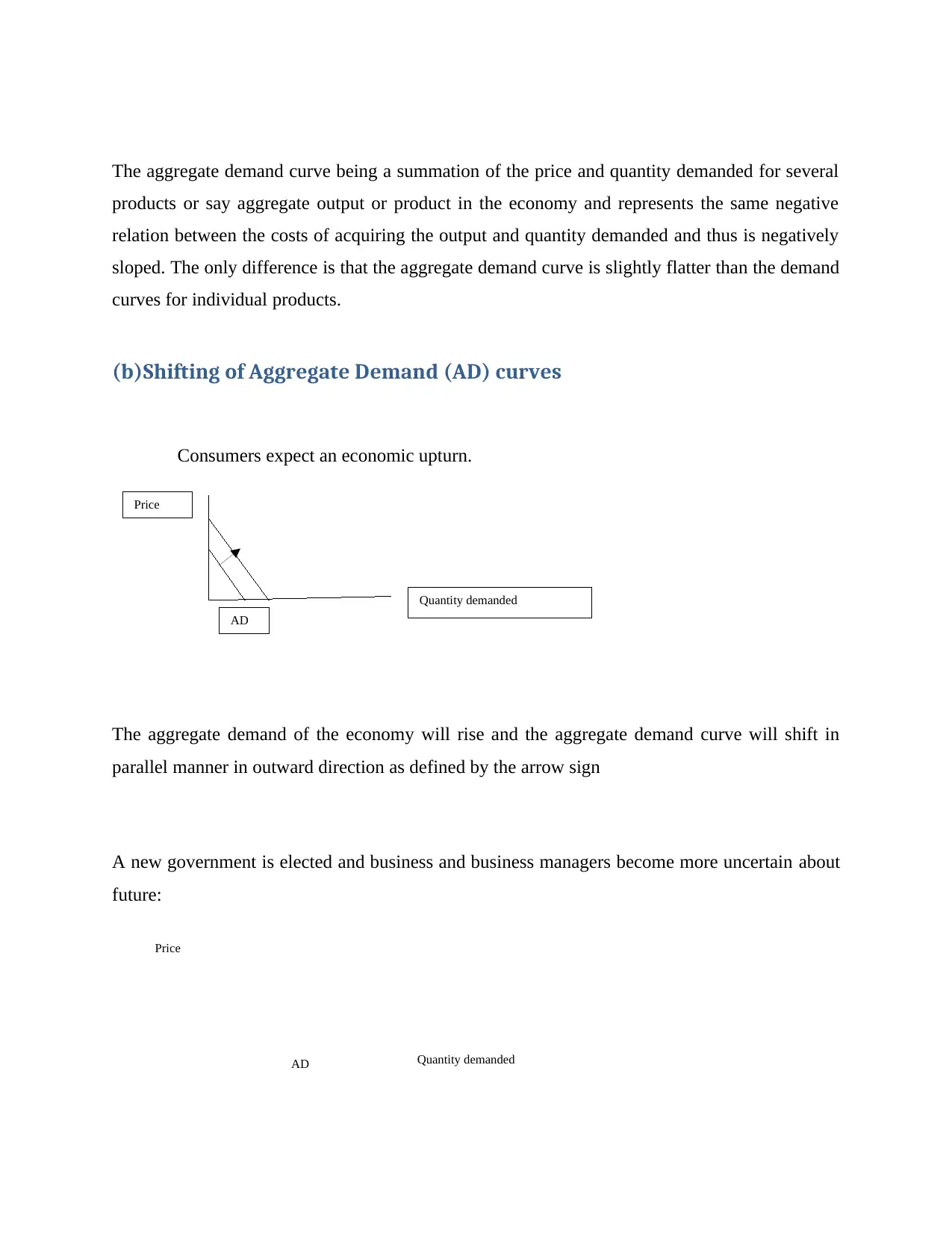
Quantity demanded
Price
AD
Quantity demanded
Price
AD
The aggregate demand curve being a summation of the price and quantity demanded for several
products or say aggregate output or product in the economy and represents the same negative
relation between the costs of acquiring the output and quantity demanded and thus is negatively
sloped. The only difference is that the aggregate demand curve is slightly flatter than the demand
curves for individual products.
(b)Shifting of Aggregate Demand (AD) curves
Consumers expect an economic upturn.
The aggregate demand of the economy will rise and the aggregate demand curve will shift in
parallel manner in outward direction as defined by the arrow sign
A new government is elected and business and business managers become more uncertain about
future:
Price
AD
Quantity demanded
Price
AD
The aggregate demand curve being a summation of the price and quantity demanded for several
products or say aggregate output or product in the economy and represents the same negative
relation between the costs of acquiring the output and quantity demanded and thus is negatively
sloped. The only difference is that the aggregate demand curve is slightly flatter than the demand
curves for individual products.
(b)Shifting of Aggregate Demand (AD) curves
Consumers expect an economic upturn.
The aggregate demand of the economy will rise and the aggregate demand curve will shift in
parallel manner in outward direction as defined by the arrow sign
A new government is elected and business and business managers become more uncertain about
future:
⊘ This is a preview!⊘
Do you want full access?
Subscribe today to unlock all pages.

Trusted by 1+ million students worldwide
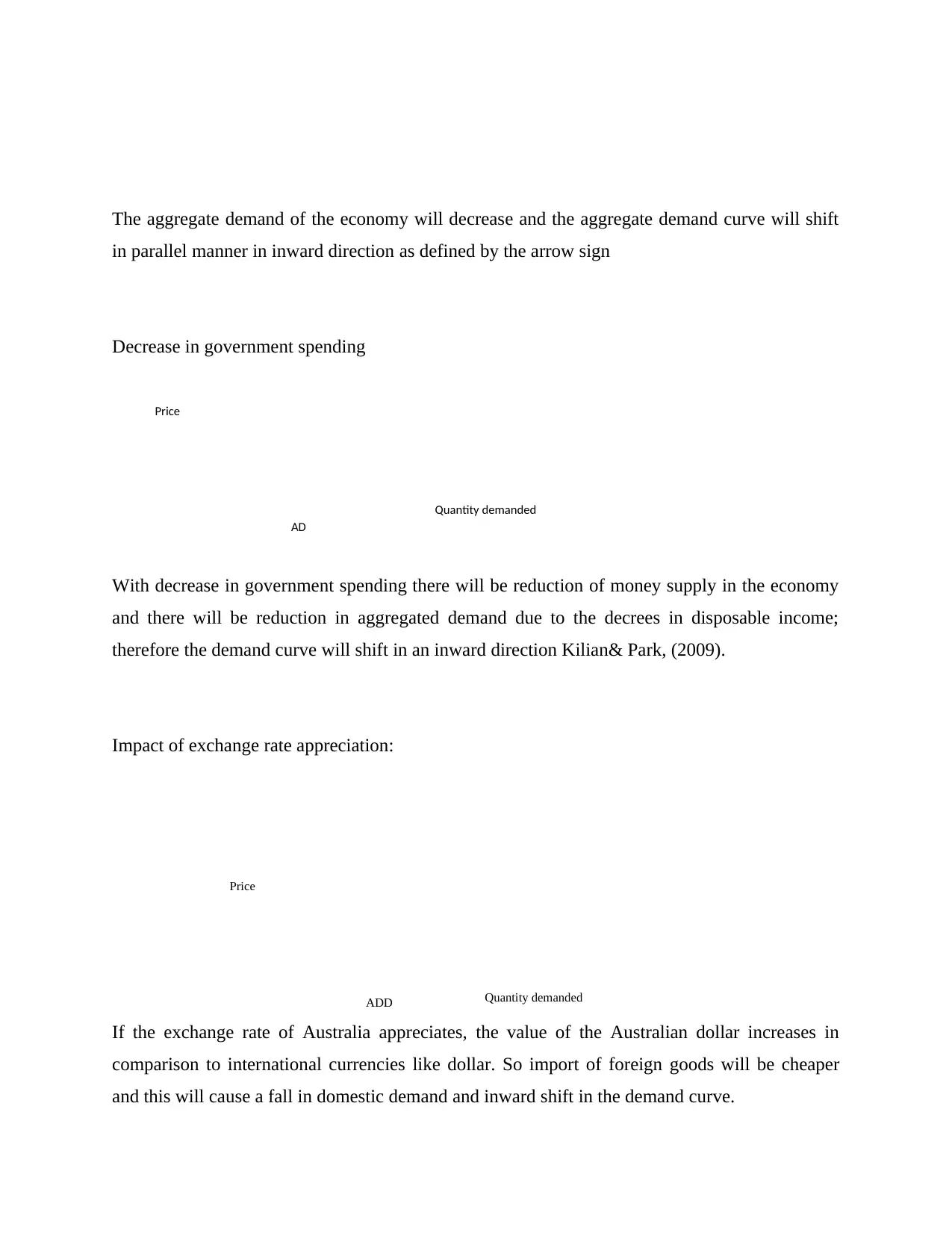
Quantity demanded
Price
AD
Quantity demanded
Price
ADD
The aggregate demand of the economy will decrease and the aggregate demand curve will shift
in parallel manner in inward direction as defined by the arrow sign
Decrease in government spending
With decrease in government spending there will be reduction of money supply in the economy
and there will be reduction in aggregated demand due to the decrees in disposable income;
therefore the demand curve will shift in an inward direction Kilian& Park, (2009).
Impact of exchange rate appreciation:
If the exchange rate of Australia appreciates, the value of the Australian dollar increases in
comparison to international currencies like dollar. So import of foreign goods will be cheaper
and this will cause a fall in domestic demand and inward shift in the demand curve.
Price
AD
Quantity demanded
Price
ADD
The aggregate demand of the economy will decrease and the aggregate demand curve will shift
in parallel manner in inward direction as defined by the arrow sign
Decrease in government spending
With decrease in government spending there will be reduction of money supply in the economy
and there will be reduction in aggregated demand due to the decrees in disposable income;
therefore the demand curve will shift in an inward direction Kilian& Park, (2009).
Impact of exchange rate appreciation:
If the exchange rate of Australia appreciates, the value of the Australian dollar increases in
comparison to international currencies like dollar. So import of foreign goods will be cheaper
and this will cause a fall in domestic demand and inward shift in the demand curve.
Paraphrase This Document
Need a fresh take? Get an instant paraphrase of this document with our AI Paraphraser
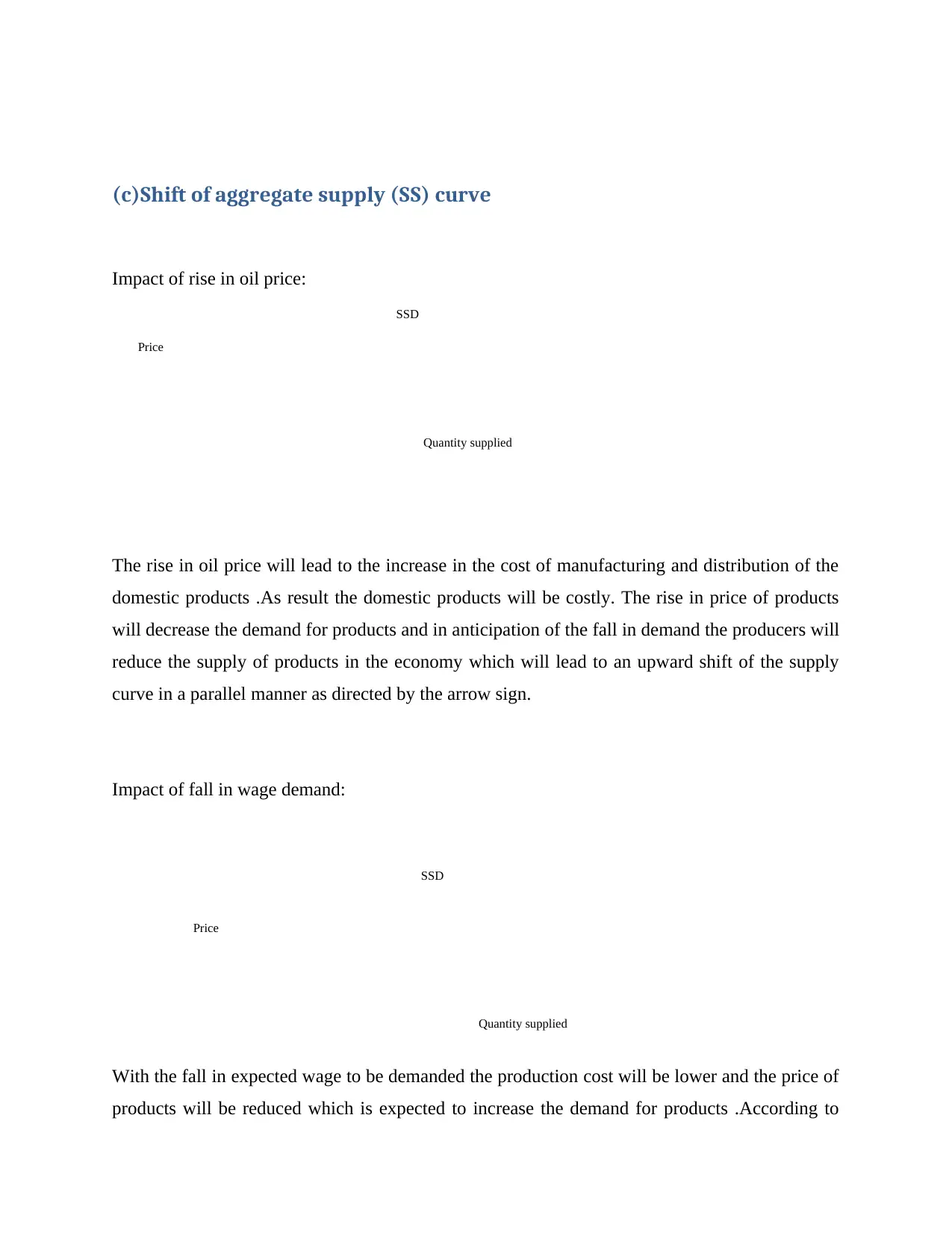
Quantity supplied
Price
SSD
Quantity supplied
Price
SSD
(c)Shift of aggregate supply (SS) curve
Impact of rise in oil price:
The rise in oil price will lead to the increase in the cost of manufacturing and distribution of the
domestic products .As result the domestic products will be costly. The rise in price of products
will decrease the demand for products and in anticipation of the fall in demand the producers will
reduce the supply of products in the economy which will lead to an upward shift of the supply
curve in a parallel manner as directed by the arrow sign.
Impact of fall in wage demand:
With the fall in expected wage to be demanded the production cost will be lower and the price of
products will be reduced which is expected to increase the demand for products .According to
Price
SSD
Quantity supplied
Price
SSD
(c)Shift of aggregate supply (SS) curve
Impact of rise in oil price:
The rise in oil price will lead to the increase in the cost of manufacturing and distribution of the
domestic products .As result the domestic products will be costly. The rise in price of products
will decrease the demand for products and in anticipation of the fall in demand the producers will
reduce the supply of products in the economy which will lead to an upward shift of the supply
curve in a parallel manner as directed by the arrow sign.
Impact of fall in wage demand:
With the fall in expected wage to be demanded the production cost will be lower and the price of
products will be reduced which is expected to increase the demand for products .According to
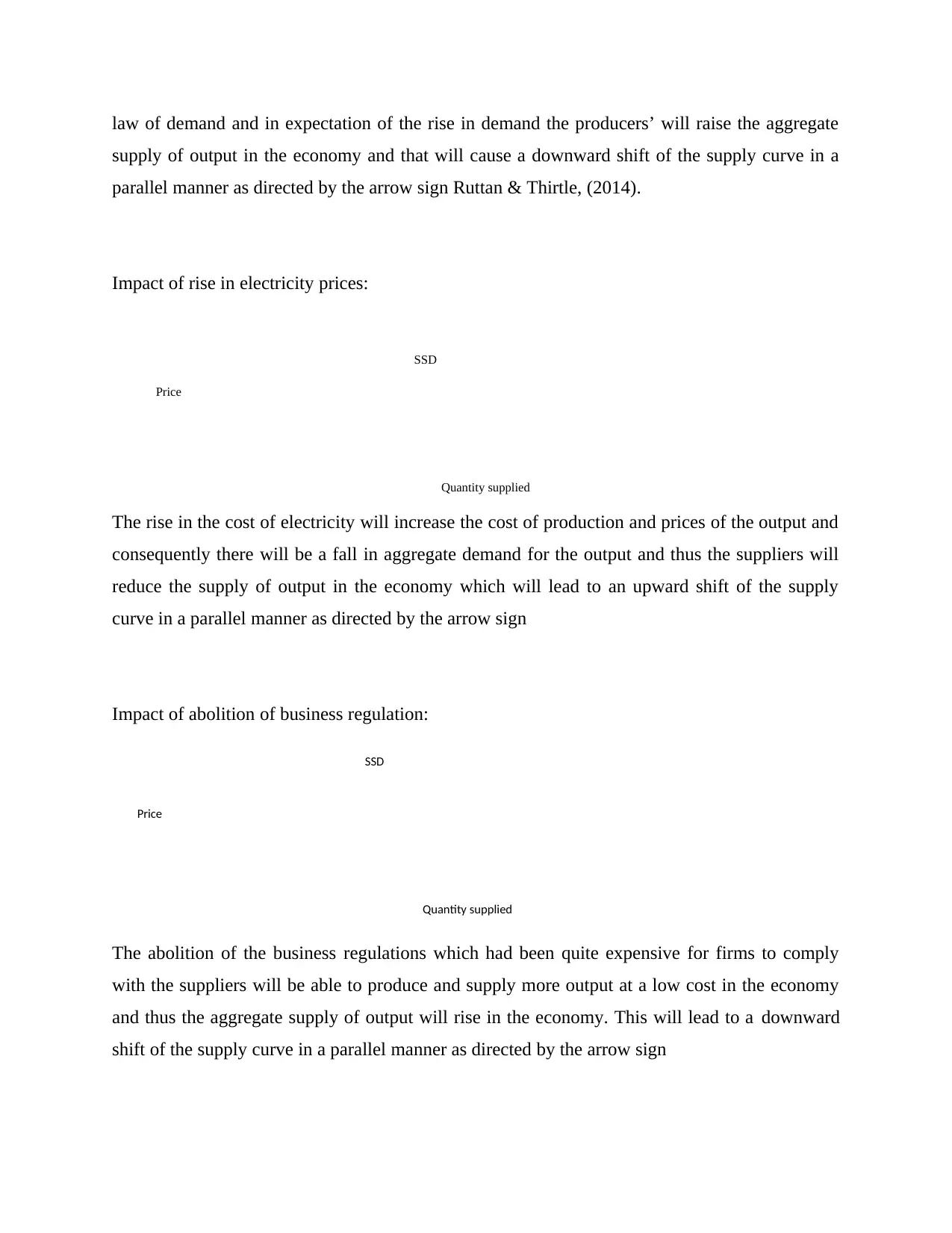
Quantity supplied
Price
SSD
Quantity supplied
Price
SSD
law of demand and in expectation of the rise in demand the producers’ will raise the aggregate
supply of output in the economy and that will cause a downward shift of the supply curve in a
parallel manner as directed by the arrow sign Ruttan & Thirtle, (2014).
Impact of rise in electricity prices:
The rise in the cost of electricity will increase the cost of production and prices of the output and
consequently there will be a fall in aggregate demand for the output and thus the suppliers will
reduce the supply of output in the economy which will lead to an upward shift of the supply
curve in a parallel manner as directed by the arrow sign
Impact of abolition of business regulation:
The abolition of the business regulations which had been quite expensive for firms to comply
with the suppliers will be able to produce and supply more output at a low cost in the economy
and thus the aggregate supply of output will rise in the economy. This will lead to a downward
shift of the supply curve in a parallel manner as directed by the arrow sign
Price
SSD
Quantity supplied
Price
SSD
law of demand and in expectation of the rise in demand the producers’ will raise the aggregate
supply of output in the economy and that will cause a downward shift of the supply curve in a
parallel manner as directed by the arrow sign Ruttan & Thirtle, (2014).
Impact of rise in electricity prices:
The rise in the cost of electricity will increase the cost of production and prices of the output and
consequently there will be a fall in aggregate demand for the output and thus the suppliers will
reduce the supply of output in the economy which will lead to an upward shift of the supply
curve in a parallel manner as directed by the arrow sign
Impact of abolition of business regulation:
The abolition of the business regulations which had been quite expensive for firms to comply
with the suppliers will be able to produce and supply more output at a low cost in the economy
and thus the aggregate supply of output will rise in the economy. This will lead to a downward
shift of the supply curve in a parallel manner as directed by the arrow sign
⊘ This is a preview!⊘
Do you want full access?
Subscribe today to unlock all pages.

Trusted by 1+ million students worldwide
1 out of 14
Related Documents
Your All-in-One AI-Powered Toolkit for Academic Success.
+13062052269
info@desklib.com
Available 24*7 on WhatsApp / Email
![[object Object]](/_next/static/media/star-bottom.7253800d.svg)
Unlock your academic potential
Copyright © 2020–2025 A2Z Services. All Rights Reserved. Developed and managed by ZUCOL.




